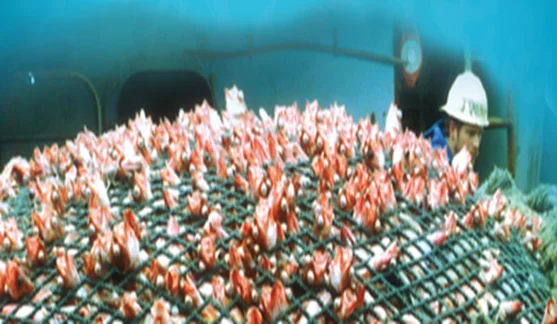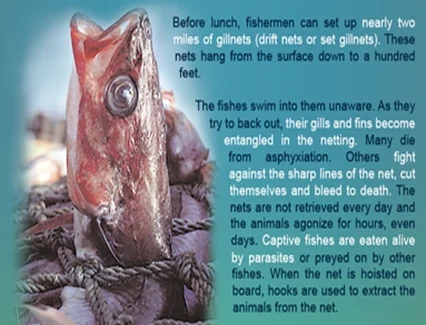CALIBRATED FISH CATCHING
A new concept has been set out which is explained in several technical solutions, how to use the available resources for selective fishing. Ships that are using the current method of fishing with nets are becoming unprofitable and harmful to the sea ecosystem, which is not the case in our innovative technology. Instead of current fish nets, feeders are used as bait in the platform that is catching the fish. By using our innovative technology, large fish are caught, while small fish can pass through the passages in a perforated canvas or net. In this case, fish catching is 100% safe for small fish that are allowed to grow naturally to full maturity, and not die massively during the hunting which is the case in current methods. The picture below shows the current way of fishing.
Today, fish are mostly caught in nets that are in open waters and with the help of boats. Surface and deep nets are used. With its retreat, the deep networks are destroying the sea bottom ecosystem. When nets are torn, they mostly remain thrown away on the sea bottom. Millions of already thrown away nets are a danger to animals and fish, which subsequently become captured in them, where they die. The current method of fishing would be replaced by selective and humane fishing, all with the help of the described fish catching platform.
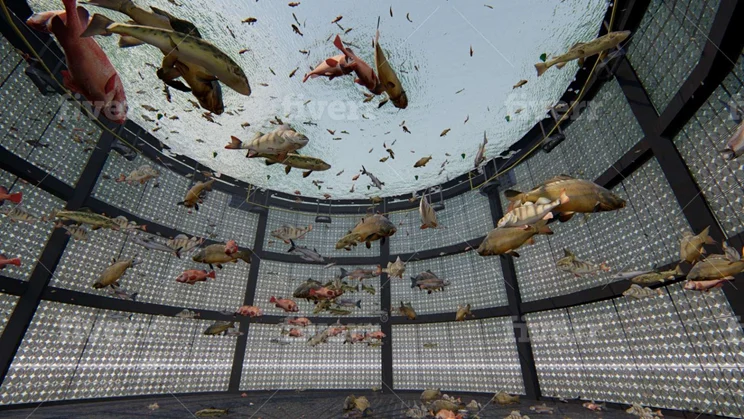 The use of fishing platforms will reduce the use of fishing boats, rationalize the use of ecosystems and improve the technical way of fishing. Conditions will be created so the ecosystem can recover and will allow young fish to grow to full maturity. The innovation provides the opportunity for fishing to have the same capacity compared to the use of current methods, with a tendency to increase rather than decrease the catches as currently is the case.
The use of fishing platforms will reduce the use of fishing boats, rationalize the use of ecosystems and improve the technical way of fishing. Conditions will be created so the ecosystem can recover and will allow young fish to grow to full maturity. The innovation provides the opportunity for fishing to have the same capacity compared to the use of current methods, with a tendency to increase rather than decrease the catches as currently is the case.
The platform for catching fish is made of interconnected rings, or nets stretched between the supporting structure. When the platform is in motion, water and small fish are passing through it, while large fish are been caught. Fish that cannot pass through the appropriate dimensions of the opening will be caught at the water level. The dimensions of the openings are of the appropriate size which is necessary for catching the appropriate type and size of the fish. Circular openings are convenient, but not the only solution. These can be ellipse-shaped openings, lattice-shaped passages, etc.
The movement of the platform is controlled and directed by the direction of vertically placed cables at the edge of the platform, which serve as guides. The cables are tightened and placed in the direction from the bearing buoys in the water surface, to the anchors located at the bottom of the sea. The platform moves at a sufficient speed with the projected water resistance. All operating parameters of the platform are controlled by an electronic device with the help of sensors and cameras and other equipment. The equipment will be placed on the platform itself, connected by cables to buoys on water surface. The signal buoy can also be separated from the structure to float independently.
The platform is connected by signals to the feeder buoy, a place on land from which fish catching or surveillance is controlled. This, technically equipped platform would provide current information on how many fish were caught and in what period of time, is a sufficient number of fish caught for a profitable commercial catch, etc. Should an insufficient quantity or protected species of fish be caught, the platform would get lower and automatically return to the starting position for a future better attempt to catch fish. On that occasion, the caught fish would be safely released, and a more successful hunt will follow.
The platform for catching fish in the seas and oceans can be larger or smaller than 100 m in diameter. These are large dimensions of the platform with the necessary equipment, where it is not technically possible to be load on a ship. The fish is separated in one part of the platform, where it is then sucked in with water pipes and placed on the boat, and then the platform is returned to its starting position. This way of catching fish, contributes to reducing the use of unprofitable crews, enables controlled and selective fishing with automated equipment.
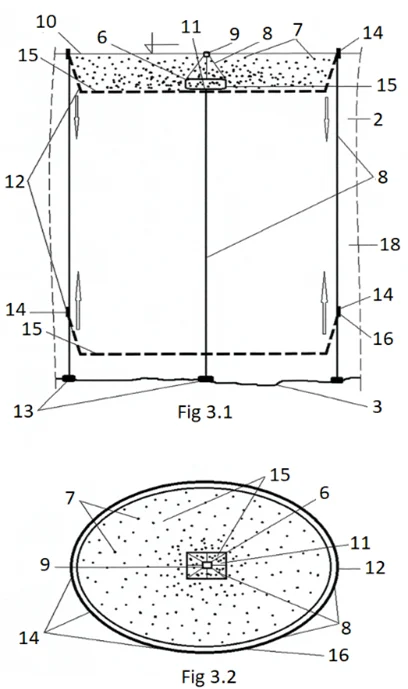 In Fig. 3.1 is a side view of parts of two platforms 12 for catching fish 7 by calibration, all in accordance with the present invention. Platform 12 for catching fish 7 is provided in its working position, moving up and down with cables 8 and anchors 13. On the structure are in order placed chambers filled with air 14, evenly distributed around the perimeter of the platform 12. The platform 12 is positioned vertically towards the bottom 3 at a certain depth. The platform 12 for catching fish 7 with the help of a number of devices 16, has the technical ability to work manually or automatically. Necessary devices 16 are placed on cables 8, platform 12, independent buoy. The devices 16 are interconnected, in order to control the work process with the help of sensors and cameras. When the fish 7 is in the feeder zone 6, the platform 12 automatically or manually reacts and later monitors the affected fish 7. With the help of a constant thrust force generated by distributed air-filled chambers 14, the platform 12 accelerates fish 7, enough oxygen is provided in the water to survive for several days.
In Fig. 3.1 is a side view of parts of two platforms 12 for catching fish 7 by calibration, all in accordance with the present invention. Platform 12 for catching fish 7 is provided in its working position, moving up and down with cables 8 and anchors 13. On the structure are in order placed chambers filled with air 14, evenly distributed around the perimeter of the platform 12. The platform 12 is positioned vertically towards the bottom 3 at a certain depth. The platform 12 for catching fish 7 with the help of a number of devices 16, has the technical ability to work manually or automatically. Necessary devices 16 are placed on cables 8, platform 12, independent buoy. The devices 16 are interconnected, in order to control the work process with the help of sensors and cameras. When the fish 7 is in the feeder zone 6, the platform 12 automatically or manually reacts and later monitors the affected fish 7. With the help of a constant thrust force generated by distributed air-filled chambers 14, the platform 12 accelerates fish 7, enough oxygen is provided in the water to survive for several days.
The platform 12 catches the fish 7 in its movement and traps it in the water level 10. Then the chambers 14 and part of the construction of the platform 12 come out above the water level 10. The platform 12 is pulled towards the bottom 3 with the electric motor that contains the reductor and breaks, by cables that are vertically placed 8. Electricity is obtained from the battery, charged from the place of distributed solar panels on the buoy 9. The brakes are opened and closed, if necessary, at the place of the included cable 8.
In Fig. 3.2 is a top view of a fish catching platform 12 with a feeder 6, where a net of 15 traps is tightened. The net 15 is made with holes, which calibrates the caught fish 7. In this way, the big fish 7 cannot pass, and it remains trapped until the time of arrival of the boat 4 that catches it. The device 16 transmits information about the caught fish 7 to the mainland via sonar and signals on the buoy 9, and opposite. The necessary information is exchanged with each other.
In this solutions and positions, the design and use of materials are unlimited. Certain parts are made of thinner and thicker material, with different flexibility. The parts made in this way are less rub down in order for the technology to have long-term exploitation.
The application of technology would reduce the current indiscriminate fishing, which is now protected only by law, but not by the technological process of fishing. The shortcomings of the current fishing have been solved by applying this technology, where the death of small fish, which now suffers, is 100% avoided.
CALIBRATED FISH CATCHING (ADDITION)
The innovative solution has three main goals of technology application. The first goal is to form the previously described mega fisheries in which the fish is feeding freely by setting up new feeders. The second goal is to form a place for feeding fish with an automatically calibrated catch of fish in the seas, oceans, reservoirs, ponds and rivers. Hunting does not include the use of classic boats, neither the use of classic nets. The third goal is to build a cage in several variants, where the feeder is used as bait for catching the fish. The technology contributes to the protection of sea farms from predatory fish. By applying this innovation, fish are selectively caught with appropriate numerous openings.
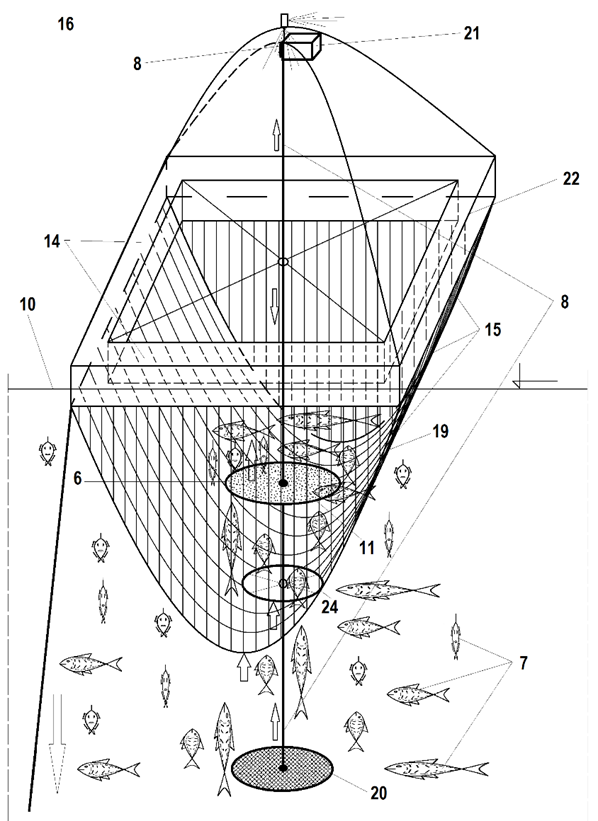 The figure shows a three-dimensional bending basket 19 equipped with a feeder 6, attached to a structure 22 floating in the water level 10. Here, the position of the opening on the structure 24 is occasionally opened and closed by a cable winch 8. The cable winch 8 is moving by electric motor with reducer 21. The bending basket 19 together with the feeder 6 is moving up and down in relation to the water level 10. The shutter 20 is a support for raising the basket 19 in the direction of the water level 10, when large fish 7 remains trapped in it. The catch selection process is the same as in the other examples. The fish 7 is calibrated by passing through numerous openings in the net with hooks 15. The basket 19 floats at water level 10 with a help of chambers filled with air 14 or with a structure filled with Styrofoam. At the opening of the structure 24, the cable 8 is centered for moving up and down. In this way, the opening 24 is closed by the shutter 20, which then rests properly on the opening 24. This is the only place where large fish 7 can enter on the way to the feeder 6. Additionally, a tent is placed on the chambers 14. An electric motor with a reducer and a winch 24 is placed on the top of the structure or at the top of the tent, as well as a device for signaling and controlling the operation of the catcher 16 with the feeder 6.
The figure shows a three-dimensional bending basket 19 equipped with a feeder 6, attached to a structure 22 floating in the water level 10. Here, the position of the opening on the structure 24 is occasionally opened and closed by a cable winch 8. The cable winch 8 is moving by electric motor with reducer 21. The bending basket 19 together with the feeder 6 is moving up and down in relation to the water level 10. The shutter 20 is a support for raising the basket 19 in the direction of the water level 10, when large fish 7 remains trapped in it. The catch selection process is the same as in the other examples. The fish 7 is calibrated by passing through numerous openings in the net with hooks 15. The basket 19 floats at water level 10 with a help of chambers filled with air 14 or with a structure filled with Styrofoam. At the opening of the structure 24, the cable 8 is centered for moving up and down. In this way, the opening 24 is closed by the shutter 20, which then rests properly on the opening 24. This is the only place where large fish 7 can enter on the way to the feeder 6. Additionally, a tent is placed on the chambers 14. An electric motor with a reducer and a winch 24 is placed on the top of the structure or at the top of the tent, as well as a device for signaling and controlling the operation of the catcher 16 with the feeder 6.
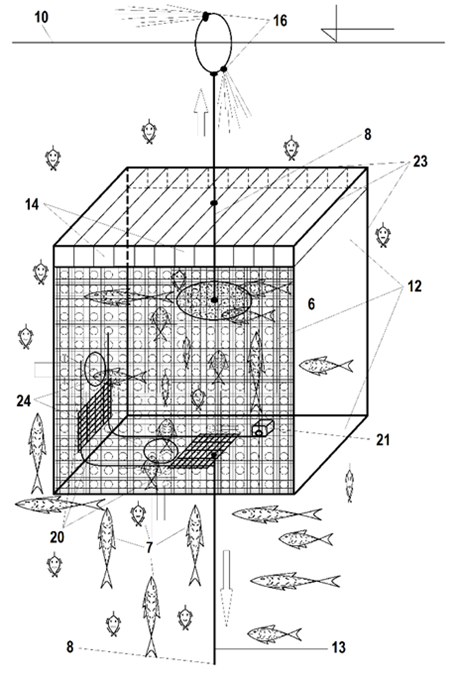 The figure shows a three-dimensional view of the cage, construction 23 made of a bars in which the feeder 6 is located, with the position of several openings 24 which are simultaneously closed and opened with the help of the toothed rack and sprocket, flexible shutter 20. The drive is provided by electric motor 21 and gear where the work process selectively catches and feeds the fish 7 to the catch. The structure 23 is located below the water level 10, positioned by air-filled chambers 14, connected to the anchor 13 by associated cables 8. Above the water level 10, only a buoy with a signaling and control device 16 is placed, with cables 8. The cage is for use in open waters when the fish 7 freely enters and exits, feeds at the feeder site 6 until the opening 24 is closed. The fish 7 is generally calibrated by passing through the cage bars or in the way already described. It’s kept until the moment of capture.
The figure shows a three-dimensional view of the cage, construction 23 made of a bars in which the feeder 6 is located, with the position of several openings 24 which are simultaneously closed and opened with the help of the toothed rack and sprocket, flexible shutter 20. The drive is provided by electric motor 21 and gear where the work process selectively catches and feeds the fish 7 to the catch. The structure 23 is located below the water level 10, positioned by air-filled chambers 14, connected to the anchor 13 by associated cables 8. Above the water level 10, only a buoy with a signaling and control device 16 is placed, with cables 8. The cage is for use in open waters when the fish 7 freely enters and exits, feeds at the feeder site 6 until the opening 24 is closed. The fish 7 is generally calibrated by passing through the cage bars or in the way already described. It’s kept until the moment of capture.
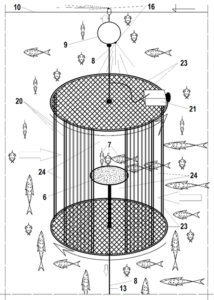 The picture shows a three-dimensional roll-shaped trap, which has a static lower and upper structure, with a series of openings 24 on the structure which are approximately proportional to half of the vertical surface of the roller. Here, an electric motor with a reducer 21 and a sprocket moves the openings 24 on the roller construction and rotates them in the opposite direction. In this way, the openings 24 on the construction of the roller opens and closes in a controlled manner and selectively catch and nurture the fish 7 until they are caught. The roller trap is located below the water level 10 with a help of a buoy 9 and the cable 8 connected to the anchor 13. The roller trap can be placed on open waters with a help of a classic buoy 9. The feeder 6 is hung on the upper part of the catcher with a cable 8, so that the fish 7 can enter it. Fish 7 is mostly calibrated by passing through bars. The openings are designed so that predatory fish do not enter the trap.
The picture shows a three-dimensional roll-shaped trap, which has a static lower and upper structure, with a series of openings 24 on the structure which are approximately proportional to half of the vertical surface of the roller. Here, an electric motor with a reducer 21 and a sprocket moves the openings 24 on the roller construction and rotates them in the opposite direction. In this way, the openings 24 on the construction of the roller opens and closes in a controlled manner and selectively catch and nurture the fish 7 until they are caught. The roller trap is located below the water level 10 with a help of a buoy 9 and the cable 8 connected to the anchor 13. The roller trap can be placed on open waters with a help of a classic buoy 9. The feeder 6 is hung on the upper part of the catcher with a cable 8, so that the fish 7 can enter it. Fish 7 is mostly calibrated by passing through bars. The openings are designed so that predatory fish do not enter the trap.
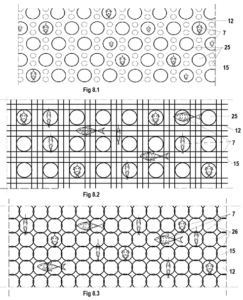 I n Fig. 8.1 a part of the net with rings 15 is separated, the arrangement and location of perforations and circular openings 25 are shown. The openings 25 are additionally covered with rubber, plastic or other materials. Net with rings 15, can be additionally reinforced by steel or plastic net.
I n Fig. 8.1 a part of the net with rings 15 is separated, the arrangement and location of perforations and circular openings 25 are shown. The openings 25 are additionally covered with rubber, plastic or other materials. Net with rings 15, can be additionally reinforced by steel or plastic net.
Fig. 8.2 shows a net 15 made with circular openings 25.
Fig. 8.3 shows the interconnected rings 26. Metal rings 26 continue as a chain and it is a supporting structure, while plastic rings 26 can fill the gap by making a curtain or net 15. Small fish 7 pass through openings 25, while large ones remain.
CURRENT FISH LOSSES IN FISHING
Industrial fish mortality in fishing
Industrial fishing is now extremely brutal and in that way the fish stock is being destroyed. About a quarter of the catch is discarded into the sea. One third is converted into fish flour and oil, which is used, among other things, to feed domestic animals, including fish and crabs. Fishing kills billions of small fish every year. In most cases, their death is neither quick or painless.
Ruthless fish hunting
In many cases of fishing, a shoal of fish is caught in a huge net. Usually, heavy chains attached to net scrape the ocean bottom to chase away fish, leaving a devastated desert behind. The fish are scared and swim to exhaustion. They are concentrated at the end of the net where the fish are squeezing each other for hours, and various types of debris and stones are peeling them. Severely wounded, pressed against each other, sometimes they can’t even breathe.
During the rapid exit from the depths, decompression causes their swimming bladder to explode, eyes pop out of the skull, esophagus or gizzard out of the mouth. Small fish are thrown into the ice, where they are dying slowly from suffocation or are crushed by other layers of fish. Meanwhile, unwanted fish are thrown over the sides of ships, sometimes piercing them with pitchforks.
Deadly nets in fishing
Nets are used to catch shallow fish (sardines, anchovies, herring, tuna …). Fishing boats place the nets vertically in relation to the surface of the water, sometimes they are kilometers long when they catch a shoal of fish. These nets, several tens of meters high, are squeezed around a shoal of fish, which are then lifted into the ship. Some fish die crushed or suffocated in this process. The others die from heat shock when they are thrown into the liquid on the edge of freezing.
Prisoners of the net
In a short time, fishermen can set up several kilometers of standing nets. These nets are hanging from the surface of the water up to tens of meters in the depth of the water, fish unconsciously swim in them when the net catches them by the gills and fins. As they try to get out, their gills and fins become more and more entangled in the net. Many fish die from suffocation. Other fish fight the sharp lines of the net, cut and bleed to death. The set nets are not pulled out every day and the fish are tortured for hours, even days. Also, fish in captivity are eaten by parasites or are prey to other predatory fish.
Immeasurable suffering leading to great mortality
Longlines can be miles long, when they carry hundreds or thousands of bait hooks. They lie at the bottom of the sea, at medium water level or close to the water surface. They are used to catch larger fish such as swordfish, tuna or sharks, small fish. Many fish swallow the hook, which then passes through their stomachs. As in the previous case with standing nets, some longlines are taken out within a few hours, sometimes few days, when the fish is suffering.
Approximately 25% of the fish caught are thrown back into the sea, dead, injured or exhausted because they are too small or unwanted. This massacre has been increasing since minimum catch sizes and fishing quotas were approved. Young fish are still being caught, but are now being thrown back into the sea, usually when they are dead. When the quotas for catching one species are achieved, all fish of this species will be rejected for redemption as fishing continues to achieve quotas for other species.
Excessive fishing leads to the extinction of fish
We are talking about overfishing, when the catch becomes so large that entire fish populations cannot be renewed and when they are threatened with complete extinction. Economists and environmentalists warn of the collapse of fishery resources. 10% of the fish population was overexploited in 1974, and by 2011 this number had risen to 30%. Today, 60% of the fish population is fully exploited.
Innovative technologies in fisheries are insufficiently applied, and the number of fishing boats is growing. Today, the number of caught fish exceeds 100 million metric tons per year. Fishing is increasing every year, so there are less and less fish in natural conditions.
Fishing is causing the mass extinction of sea species and bringing disaster to sea ecosystem, more than pollution or global warming.
Current fisheries are not productive
World production of fish from fisheries is growing rapidly. Fisheries now provide more than 50% of the world’s consumption of fish and shrimps which is used for human consumption.
Hundreds of billions of fish live short and inhumane lives, packed in underwater cages, pools or reservoirs. Some fisheries are prisons with half a million animals inside.
Their lives in these crowded conditions are full of stress, frustration and aggression. Injuries are common, and animals are affected by parasites that eat meat, and therefore are exposed to constant infections. Mortality is often very high.
It is planned to raise many more animals in fisheries than in all land farms, where chickens, pigs, sheep, cows, calves, goats, etc. are exploited.
It is planned that the production of fish in fisheries will increase by 29 million metric tons annually, in the next 10 years. Our innovative technology has the perspective of unlimited and cost-effective application in the expansion of the world’s fisheries, and then the fish would live in humane conditions.


